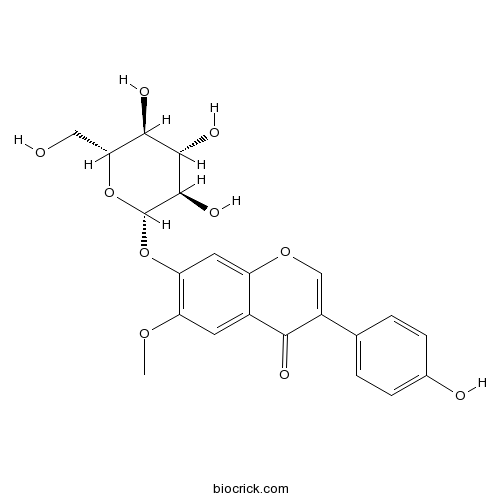A glycosyloxyisoflavone that is isoflavone substituted by a methoxy group at position 6, a hydroxy group at position 4' and a β-D-glucopyranosyloxy group at position 7.
InChI=1S/C22H22O10/c1-29-15-6-12-14(30-9-13(18(12)25)10-2-4-11(24)5-3-10)7-16(15)31-22-21(28)20(27)19(26)17(8-23)32-22/h2-7,9,17,19-24,26-28H,8H2,1H3/t17-,19-,20+,21-,22-/m1/s1
An isoflavone glycitin is isolated from the licorice, which has good inhibitory effect on α-glucosidase with IC50of 0.5646 mg·mL- 1, better than the position control acarbose. [1]
Glycitin, daidzin, and genistin may modulate differentiation of MSC to cause a lineage shift toward the osteoblast and away from the adipocytes, and could inhibit adipocytic transdifferentiation of osteoblasts, they could also be helpful in preventing the development of osteonecrosis.[2]
Glycitein has a protective effect on skin aging by inhibiting of MMP-1 and increasing of collagen through ERK/JNK/P38 down-regulation, which may be mediated by the inhibition of ERK, JNK, and p38 mitogen-activated protein kinases, suggests that glycitin is a potential agent for the treatment of skin ageing.[3]
A mixture of daidzin and glycitin has anti-obese and anti-diabetic effects on C57BL/6J mice fed with a high-fat diet by the regulation of oxidative stress .[4]
[1] Feng C, Weiwei Y U, Gan Q, et al. Sci Technol Rev, 2014, 32(16):29-33.
[2] Xiang-Hui L I, Zhang J C, Sui S F, et al. Acta Pharmacol Sin, 2005, 26(9):1081-6.
[3] Seo G Y, Park S, Huh J S, et al. J Korean Soc App Bi, 2014, 57(4):463-8.
[4] Zang Y, Igarashi K, Yu C. Biosci Biotech Bioch, 2014, 79(1):117-23.
[5] Bo R U, Zhang Y H, Zhang Y. Practical Pharmacy & Clinical Remedies, 2011, 14(2):138-40.



